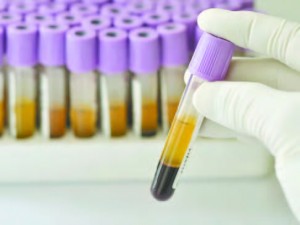New ‘Vampire’ PRP Treatment May Rejuvenate Dying Follicles
By Alan J. Bauman, M.D.
 What do Tiger Woods, Rafael Nadal, Kobe Bryant, Kim Kardashian and Angelina Jolie have in common?
What do Tiger Woods, Rafael Nadal, Kobe Bryant, Kim Kardashian and Angelina Jolie have in common?
The answer is that they have all reportedly used their own blood as a cutting-edge non-surgical regenerative medical treatment. Studied in over 6,500 published scientific papers, the use of concentrated blood platelets, or “platelet-rich plasma,” has been used as a regenerative treatment for decades in the fields of dentistry, orthopedics and plastic surgery. PRP has recently gained increased attention from professional athletes for its ability to accelerate injury recovery – and Hollywood celebrities have also flocked to it as a way to maintain a youthful facial appearance without surgery.
More recently, PRP, often referred to as the “vampire” cell therapy treatment, is also becoming more widely used among hair restoration specialists due to its hair regrowth potential. In fact, a recent study published in the British Journal of Dermatology found PRP to perform better than standard medical treatments for patients with the autoimmune hair loss disorder known as ‘alopecia areata.’
But how does the new vampire therapy breathe new life into failing follicles?
Why Use Platelets for Hair Growth?
Platelets are tiny cells that are critical to healing and are the body’s primary source of natural bioactive growth factors for wound healing and tissue regeneration. Platelets contain many powerful proteins, cytokines and growth factors, such as:
• Connective Tissue Growth Factor (CTGF)
• Platelet Derived Growth Factor (PGDF)
• Transforming Growth Factor-beta (TGF-β)
• Epidermal Growth Factor (EGF)
• Insulin Growth Factor (IGF)
• Vascular Endothelial Growth Factor (VEGF)
Published studies suggest that these blood-derived growth factors can play an important role in regulating hair follicle function – making them an effective treatment for both alopecia areata and the more common ‘androgenetic alopecia’ (i.e., male- and female-pattern hair loss). The basic premise is that when these growth factors are highly concentrated in PRP and reinjected into the affected areas of the scalp, they send cellular signals to reverse the miniaturization of hair follicles, helping them produce hair which is thicker, longer and stronger—providing a fuller head of hair, better coverage and less shedding. Some of the scientific reports and our own experience in treating hair loss patients with PRP at Bauman Medical Group have shown dramatic reversal of areas of balding scalp.
How is a PRP treatment performed?
A PRP hair growth treatment is a quick outpatient procedure that takes less than one hour in the doctor’s office. At the time of treatment, a small blood sample is obtained from the patient and stored in a sterile test tube (just like at a regular doctor’s visit). The test tube is then spun at high speeds in a special centrifuge in order to separate the platelets from the different components of the blood and create platelet-rich plasma. After preparing the scalp, the PRP is painlessly injected into the areas of weak hair growth. As part of the treatment, an Eclipse MicroPen™ microneedling device is used to create microtrauma on the surface of the scalp immediately following the injection. This further stimulates the release of the growth factors from the platelets and enhances their influence on cellular activity at the level of the follicles.
What are the risks of PRP treatment?
Results can vary because every patient is unique. After the procedure, most patients will only require Tylenol to help with mild discomfort, if any. There is no downtime or recovery period with PRP, so patients can go about their normal routines immediately after treatment and can even shower and shampoo their hair that same night.
Since the treatment is autologous—i.e., made from cells within your own body—there is no risk of allergic reaction, disease transmission, side effects or drug complications. Since the blood is taken, processed and reinjected, a minimal risk of infection (<1%) is always present, but it’s on a par with a standard blood draw and much lower than other types of injectable cosmetic procedures. In the medical literature, side effects and complications from PRP injections are extremely rare. Over time, repeat treatments may be needed to achieve and/or maintain the desired result.
Are all PRP treatments the same?
Unfortunately they are not. Many physicians use different protocols to create and apply PRP. At Bauman Medical Group, we use the only FDA-approved PRP preparation system, called Autologel™, to prepare create the PRP and often choose to enhance the treatment with ACell™ or other advanced extracellular matrix products. At Bauman Medical, all medical staff members have been officially trained and certified by Cytomedix to prepare FDA- approved Autologel PRP since 2011.
How do I know if my PRP hair growth treatment is working?
Before the treatment, the area of concern should be microscopically evaluated, photographed and measured using the scientific HairCheck device. Although results vary, some improvement in hair growth should be measureable within 90 days, with hair growth continuing to improve at six months. Since everyone responds differently, routine follow-up and measurements can be helpful in determining when PRP should be repeated or other treatment options considered.
Can PRP be combined with other hair regrowth therapies?
Absolutely, a multi-therapy approach may be needed depending on the severity of the patient’s hair loss. PRP may be used as an adjunct to FDA-approved medications like finasteride or minoxidil, or other therapies like low level laser therapy, compounded Formula 82M minoxidil, nutritional supplementation and hair transplantation.
Is PRP right for me?
If you are suffering from increased hair shedding, decreasing volume, weakening hair quality or a loss of coverage on the scalp, you may be a candidate for PRP hair growth treatment. However, a detailed and comprehensive medical hair loss evaluation by a full-time hair restoration physician and pre-treatment HairCheck measurement is recommended. (To find a qualified PRP hair restoration specialist, go to PRPHairRestoration.com) You should discuss with your hair restoration physician which additional treatments might be needed to achieve your hair restoration goals. To find out if you are a candidate for PRP hair regrowth treatments, contact hair loss expert, Alan J. Bauman, M.D. at doctorb@baumanmedical.com or call 561-394-0024 for a confidential consultation.
 South Florida Health and Wellness Magazine Health and Wellness Articles
South Florida Health and Wellness Magazine Health and Wellness Articles




